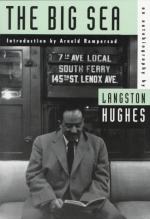
|
| Name: _________________________ | Period: ___________________ |
This test consists of 15 multiple choice questions and 5 short answer questions.
Multiple Choice Questions
1. What was "Fire?"
(a) A "Quarterly for Negro Intellectuals" first published in 1927.
(b) A magazine started by John Davis to expose new black writers.
(c) A book written by Wallace Thurman.
(d) A "Negro Quarterly of the Arts" published by Hughes and other influential blacks.
2. What was the "Interstate Tattler?"
(a) A respected black column in the New York Times.
(b) A weekly black newspaper.
(c) A monthly black magazine.
(d) A jazz gossip rag.
3. What was the name of the poem that won Hughes his first poetry prize?
(a) "The Black Man's Blues."
(b) "The Weary Blues."
(c) "The Black Walking Stick."
(d) "The Blues Woman."
4. What did Hughes by in a shop on Poydras Street that found him on his way to Havana the next day?
(a) Voodoo Powder.
(b) Go-and-Stay Powder.
(c) Good Luck Powder.
(d) Wishing Powder.
5. What was Bruce the chef's reaction to being fired from the Grand Duc?
(a) He left without saying a word to anyone.
(b) He threatened the boss with a sharp kitchen knife, frightening customers away.
(c) He clamly walked out of the back door and set the back of the building on fire.
(d) He screamed at the boss and threw a chair at him.
6. How did Hughes meet Bricktop Ada Smith?
(a) She was a waitress in his favorite coffee house.
(b) She was the new tenant in his building.
(c) She was the new singer hired at the Grand Duc.
(d) She was a fellow Metro rider every morning.
7. What was the name of Hughes's first play?
(a) "The Weary Negro."
(b) "The Walking Stick."
(c) "Not Without Laighter."
(d) "Mulatto."
8. Why did Hughes return to New Orleans and leave his job on the ship running to and from Havana?
(a) He became tired of the Chinese men on board the ship.
(b) He ran out of money and needed to earn some for school.
(c) School was starting and he wanted to spend the rest of his time in New Orleans,
(d) He grew bored with the route of the ship.
9. How did Hughes describe the cockroaches in New Orleans?
(a) They were loud and some of them flew through the air.
(b) They were the size of mice.
(c) They were the size of Buicks.
(d) They were small but noisy.
10. What area of the country was discussed by Harlem artists as the new place to live?
(a) Atlanta.
(b) California.
(c) New Orleans.
(d) New Mexico.
11. When did Hughes write his first novel?
(a) During the summer of his junior year at Lincoln.
(b) During the summer of his junior year at Columbia.
(c) During the summer of his sophomore year at Yale.
(d) During the summer of his senior year at Howard.
12. Why did Hughes disembark from the boat trip up the Saguenay River to see the northern lights?
(a) The captain refused to let him aboard the ship because he was black.
(b) The steward refused to seat him for dinner until the white passengers had eaten.
(c) The captain refused to allow him to stay in his paid-for accomodations.
(d) The steward insisted he take his dinner in the kitchen.
13. Who did Countee Cullen marry?
(a) Yolande Lincoln, granddaughter of Abraham Lincoln.
(b) Yolanda Mills, daughter of Florence Mills.
(c) Yolande Becton, daughter of the Reverend Becton.
(d) Yolande DuBois, daughter of W.E.B. DuBois.
14. Where did Hughes attend college at the height of the Negro Renaissance?
(a) Lincoln Universtiy.
(b) Columbia University.
(c) Howard University.
(d) New Yor University.
15. Why did Hughes want to return to college?
(a) To become part of Washington black society.
(b) To get a better job at the Library of Congress.
(c) To get a better background for writing.
(d) To earn more money.
Short Answer Questions
1. What was Troutbeck?
2. When and why was Hughes invited to Fisk University in Nashville, Tennessee?
3. What did people do on Seventh Street in Washington in 1924?
4. Where did Hughes stay when he arrived in Italy?
5. Who starred in "La Revue Negre" in Paris with Maude Russell and Claude Hopkins?
|
This section contains 726 words (approx. 3 pages at 300 words per page) |

|




